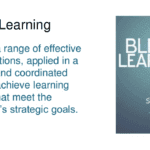This website uses cookies so that we can provide you with the best user experience possible. Cookie information is stored in your browser and performs functions such as recognising you when you return to our website and helping our team to understand which sections of the website you find most interesting and useful.
Knowledge Sharing: Tools for L&D Pros

This is part one of a three part series.
Knowledge sharing is vital. Today, more than ever, we need to leverage learning as every organization innovates to solve the problems created by this pandemic. But with people working from home, communication now is largely occurring in scheduled meetings and through online platforms, missing those important spontaneous and informal conversations.
What amazing learning is powering your organization today? And how can you empower better and faster knowledge sharing so that all learning is leveraged to help us thrive through these challenging times?
In one department, an employee might find a great online resource that helps solve a stubborn challenge and allows their work to move forward. In another, a manager provides some great coaching that improves a team’s outcomes. Somewhere else, two colleagues might work together to innovate a solution to a cross-functional problem—they give each other a virtual high five and keep on going.
Make such learning moments more visible and easier to share with others in your organization.
By empowering knowledge sharing, you leverage those powerful moments of insight, improvement, and innovation so they can be used by everyone. And you demonstrate that your organization values and promotes learning of all types.
Studies have shown that knowledge sharing is a big differentiator for high-performing organizations, with their employees sharing knowledge at four times the rate of those in lower-performing organizations. Here are a few ways L&D Pros can better empower knowledge sharings.
Create a way for people to share stories of learning moments
This will depend on what technology you have available and may include
- Sending an email to the L&D team
- Setting up a company Slack channel for learning shares
- Posting to a shared portal on the company website
- Devoting five minutes in meetings to share links or learning wins, or
- Designating a hashtag for social media posts
On Twitter, people are currently using the hashtag #AlwaysBeLearning, so if you combine something like this with your organization’s Twitter handle, you can create a fun campaign for your current employees that also builds your employer brand. There are also powerful suites of tools from Google and Microsoft that bring together your email, documents, spreadsheets, slide decks, etc. into one massive file sharing tool that seamlessly transitions from computers to phones to tablets.
Talk about learning that’s happening in your organization
You cannot do this too much. It should be an ongoing conversation that includes the informal learning you’re receiving from individual shares as well as the formal training programs and L&D events you’re hosting.
Shine a light on great learning and knowledge sharing
When you see interesting learning examples or stories, feature them in your shared channels and communications. Pick ones that exemplify best practices, amazing results, or influential people. By featuring the best, you both reward good work and you set it up as a model for others.
Make knowledge sharing accessible to others
A note of warning here: knowledge sharing can get large quickly. If you let it be a free-for-all, you might soon have hundreds of shares and no way for folks to find what they need. Engage in some curation. Think through a system or process that will work for cataloguing and displaying your company’s learning materials. You might want to consider cross-listing the same piece of learning in these ways:
- by function or department, since it’s likely that sales things will be of most interest for folks in sales, etc.
- by form, so that all videos or all PDFs, for instance, can be found together
- by topic or competency, like communication, coding, time management, or customer service.
Consider how you’ll address issues of quality control
When you empower knowledge sharing, you are going to get a range of submissions, some of which you might not want to “recommend” or put a stamp of approval on because they don’t align with your L&D brand or the organization’s brand. This is a conversation to have with your team and other stakeholders. I think it’s great to categorize submissions, so that all knowledge sharing gets put up in its own section of your portal or website, and with the formal, approved, vetted materials living together. That allows you to shine the light on the best ones--and shares moved to the “approved” category become a bit of an honor for the submitters.
Educate your teams on how to create good materials
Hosting an event on how to create good materials is another way to call attention to the launch of your knowledge-sharing efforts. You will get much better-quality sharing if you teach folks how to create an interactive PDF, edit a video, or how to use some aspects of good instructional design.
Leverage brain science with built-in rewards
We know from neuroscience research that if you want to increase something, you need to recognize and reward it. So, make sure that you always acknowledge learning shares. You might even want to track submissions by department and create some awards or even friendly competitions to make it fun and rewarding to share.
Keep the content fresh and relevant by regularly curating your own submissions
Make your learning channel a go-to resource for your teams by regularly supplying content you know is relevant, to their process, mindset, skill building, and purpose. Team members come to trust that relevant learning links will be available in the company channel, and can cut through the noise and time drain of a typical big search engine (Google, Bing, Firefox). In addition, you can extend the learning and guide your learners on event topics you have recently delivered. Select the best and most relevant options that align with the primary learning material you created, but which may provide a deeper dive or alternate method that better fits diverse learners.
Remember to give credit to source material
Materials that team members share are valuable for their learning delivery, but also for their sources and authors, whose work you can encourage learners to further explore.
Use these knowledge-sharing tools every L&D pro can use right now to help amplify the great learning that is already happening in your organization, and positively reinforce your developing culture of learning.
Continue reading why transformational learning is so important now more than ever >>
Related Blogs
JOIN OUR COMMUNITY
Be the first to know of Dr. Britt Andreatta's latest news and research.






